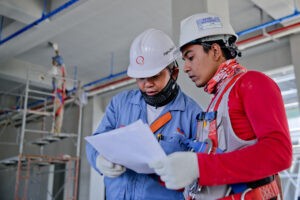Every high-risk job demands meticulous planning and stringent safety measures. A critical tool in this process is the Permiso Escrito para Trabajos de Alto Riesgo (PETAR), or High-Risk Work Permit. This document is not just a formality; it is a cornerstone of workplace safety, ensuring that hazardous tasks are undertaken with proper authorization and control.
Understanding the High-Risk Work Permit (PETAR)
A PETAR is more than just a piece of paper. It’s a detailed, written authorization that specifies the location and type of high-risk work to be performed. Crucially, each PETAR must be accompanied by a comprehensive work plan. This plan, along with the permit, should include:
- A sketch of the work area, outlining the different stages of the job.
- Specific preventative safety measures to be implemented.
- The location of all personnel involved in the task.
- Signatures of all responsible personnel, acknowledging their roles and responsibilities.
This rigorous approach ensures that all aspects of the high-risk task are considered and documented before work commences.
Who is Responsible for the PETAR?
The responsibility for creating, implementing, and overseeing the PETAR system is shared across different levels of personnel, emphasizing a collaborative approach to safety. The key individuals involved include:
Company Supervisor
The company supervisor holds primary responsibility for the PETAR process. Their duties include:
- PETAR Creation: Developing the PETAR whenever a high-risk task is identified, ensuring it’s completed and signed before work begins.
- Accurate Completion: Filling out the PETAR form accurately and comprehensively.
- Visibility and Archiving: Keeping the PETAR visible at the work site during the task and, at the end of the shift, handing over the original document to the area supervisor for archiving. These records should be maintained for at least one year.
- Procedure Communication: Ensuring all personnel under their supervision understand and adhere to the PETAR procedure and related safety protocols.
- Procedure and PETS Explanation: Clearly explaining the relevant safety procedures and the Safe Work Procedure (PETS) for the specific task to the team, ensuring comprehension and proper execution. Continuous monitoring during task execution is also essential.
- On-site Authorization: Authorizing and signing the PETAR on-site, personally verifying the work conditions and environment to confirm safety measures are in place before work begins.
- Shift Handover Communication: Providing written reports to the incoming shift supervisor about any potential hazards or risks that require attention in their supervised work areas.
Area Manager
The area manager plays a vital role in authorizing and overseeing high-risk work within their designated zone. Their responsibilities are:
- PETAR Authorization and Verification: Authorizing and signing the PETAR, personally verifying the work conditions and environment to ensure safety measures are established before the task starts.
- Area Responsibility: Taking direct responsibility for the area where the high-risk work is being carried out.
- Work Area Management: Directly managing the work area to ensure safety protocols are followed.
Worker
Workers are integral to the PETAR system’s success. Their responsibilities include:
- Procedure Compliance: Understanding, adhering to, and applying all aspects of the PETAR procedure.
- IPERC and Environmental Review: Reviewing the Baseline IPERC (Identification of Hazards and Risk Control) and Environmental Aspects Matrix before commencing work.
- PETAR Participation: Actively participating and engaging in the PETAR development process.
- Authorization Confirmation: Only starting work once the PETAR has been authorized by both their company supervisor and the area manager.
- Instruction Adherence: Understanding and diligently following all instructions outlined in the PETAR.
Occupational Safety Supervisor
The Occupational Safety Supervisor acts as a crucial support and verification role in the PETAR system. Their duties can include:
- Procedural Guidance: Advising supervisors and workers on the correct application of the PETAR procedure.
- Condition Verification: Corroborating the work conditions and environment to confirm they align with the safety conditions under which the PETAR was authorized.
- Compliance Confirmation: Randomly checking for compliance with the PETAR procedure and verifying the accurate completion of the permit form.
- PETAR Supervision: Overseeing the overall adherence to the PETAR system within the workplace.
When is a PETAR Required?
A PETAR is mandatory whenever high-risk work is to be performed. This includes situations with significant potential hazards that could lead to serious injury or illness. The PETAR must be prepared:
- Before any high-risk activity commences.
- With the participation of the area supervisor, safety supervisor (SSOMA), and the personnel performing the work.
Furthermore, the PETAR is an integral part of improving the Safety and Health Management System (SG-SST). It serves as a record that is subject to audits and can be crucial evidence during investigations of workplace accidents or occupational diseases.
Legal Framework for High-Risk Work Permits
The use of PETAR is not merely a best practice; it is often legally mandated to comply with workplace safety and health regulations. In the context of mining operations, for example, the PETAR is explicitly required under regulations such as DA 024-2016EM, which was amended and updated by D.S. N° 023-2017-EM. Specifically, Articles 36 and 130 of these regulations emphasize the mandatory and extensive use of PETAR as a primary tool for preventing high-risk work accidents.
Conclusion
The High-Risk Work Permit (PETAR) is an indispensable tool for managing safety in hazardous work environments. By ensuring proper planning, authorization, and communication, PETAR significantly reduces the risk of accidents and promotes a safer workplace for everyone. Its implementation reflects a commitment to legal compliance and, more importantly, to the well-being of workers.
For those seeking to deepen their expertise in workplace safety, consider pursuing further education in Occupational Safety and Health. Courses in this field provide valuable knowledge and skills to effectively implement and manage safety systems like PETAR, contributing to safer and more productive workplaces. Learn more about safety training programs here.
